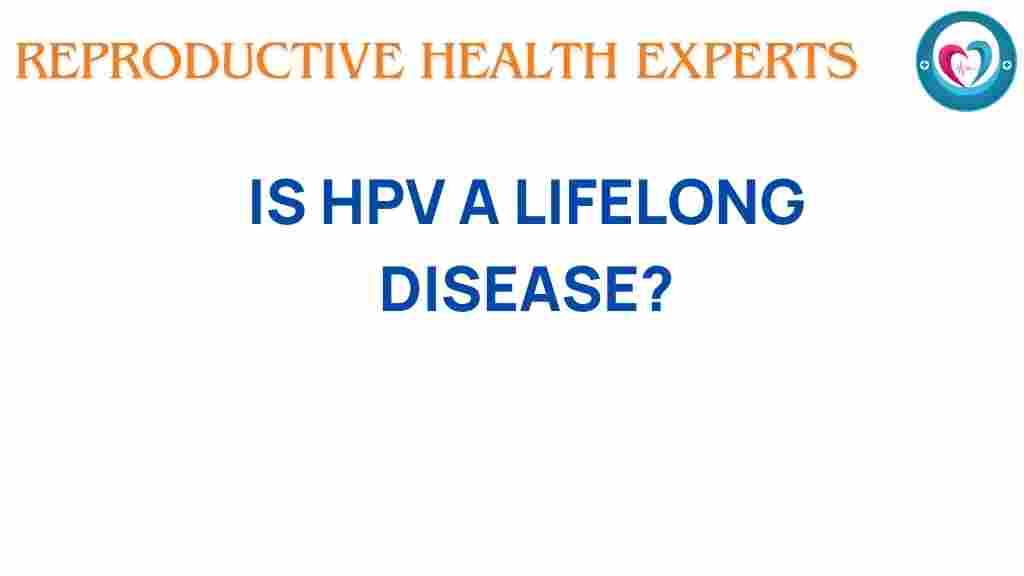Is HPV a Lifelong Disease? Unraveling the Myths and Facts
Human Papillomavirus (HPV) is one of the most common sexually transmitted infections globally. With over 200 different types of HPV, it can lead to a variety of health issues, including genital warts and several cancers. However, many people are left wondering: is HPV a lifelong disease? In this article, we will explore the facts and myths surrounding HPV, its health risks, prevention methods, treatment options, and the importance of awareness and vaccination.
Understanding HPV and Its Types
HPV is a group of more than 200 related viruses, with more than 40 types affecting the genital area. Here are some key points to understand:
- High-risk HPV types: These types can lead to cancers, including cervical, anal, and oropharyngeal cancers.
- Low-risk HPV types: These types can cause genital warts but are not associated with cancer.
While HPV is often asymptomatic and may not cause any immediate health issues, the potential long-term consequences are significant. Understanding the nature of HPV is crucial in addressing whether it is a lifelong disease.
HPV: Lifelong Disease or Not?
The question of whether HPV is a lifelong disease is complex. The answer varies based on several factors:
- Immune Response: Most individuals with healthy immune systems can clear the virus within two years. This suggests that, for many, HPV is not a lifelong disease.
- Persistent Infection: In some cases, HPV can persist and lead to health problems. High-risk HPV types can remain in the body and increase the risk of developing cancer over time.
- Type of HPV: The type of HPV contracted plays a significant role in determining the potential for long-term issues. Low-risk types typically do not cause serious health problems.
Health Risks Associated with HPV
Understanding the health risks associated with HPV is essential for awareness and prevention. Here are the main health risks:
- Cervical Cancer: HPV is the primary cause of cervical cancer. Regular screenings and Pap tests are critical for early detection.
- Other Cancers: HPV can lead to cancers of the anus, vulva, vagina, penis, and oropharynx.
- Genital Warts: Low-risk HPV types can cause genital warts, which can be uncomfortable and distressing.
Recognizing these risks underscores the importance of prevention and early intervention.
Prevention of HPV
Preventing HPV is crucial for reducing the risk of associated health issues. Here are effective prevention strategies:
Vaccination
The HPV vaccine is a highly effective way to prevent the most common and harmful types of HPV. Here are some important points about vaccination:
- Recommended Age: The vaccine is most effective when given before the onset of sexual activity, typically recommended for preteens aged 11 to 12.
- Types of Vaccines: There are several vaccines available, such as Gardasil and Gardasil 9, which protect against multiple HPV types.
- Catch-Up Vaccination: Young adults up to age 26 who have not been vaccinated should consider getting the vaccine.
For more information on HPV vaccination, you can visit the CDC HPV Vaccination page.
Safe Sexual Practices
Practicing safe sex can significantly reduce the risk of HPV transmission:
- Use Condoms: While they do not provide complete protection, condoms can lower the risk of HPV transmission.
- Limit Sexual Partners: Reducing the number of sexual partners can decrease the likelihood of exposure to HPV.
- Regular Check-ups: Regular gynecological exams and screenings can help detect any early signs of HPV-related issues.
Treatment Options for HPV
While there is no cure for HPV itself, there are treatments available for the health issues it can cause:
Management of Genital Warts
Genital warts can be treated in several ways:
- Topical Treatments: Prescription creams like imiquimod or podofilox can help in treating warts.
- Procedural Options: Healthcare providers may recommend freezing (cryotherapy), surgical removal, or laser treatment for larger warts.
Cancer Screening and Treatment
For women, regular Pap smears and HPV tests can help detect any precancerous changes early:
- Early Detection: Early-stage cervical cancer can often be treated successfully.
- Follow-up Care: Regular follow-up with healthcare providers is critical for those with a history of high-risk HPV.
Awareness and Education
Increasing awareness about HPV is crucial for prevention and management:
- Misconceptions: Many people believe that HPV is a lifelong disease or that it only affects women. Education can dispel these myths.
- Community Outreach: Engaging in community awareness programs can promote vaccination and safe practices.
It’s important to understand that HPV is common and often clears on its own. However, being informed about the risks and preventive measures is vital for everyone.
Common Misconceptions About HPV
Several misconceptions about HPV persist, leading to confusion and stigma. Here are some common myths:
- Myth 1: HPV is a lifelong disease. Fact: Most people clear the virus within two years.
- Myth 2: Only women are affected by HPV. Fact: HPV affects both men and women.
- Myth 3: You can tell if someone has HPV. Fact: Many people with HPV do not show symptoms.
Conclusion
In conclusion, while HPV can lead to serious health risks, it is not necessarily a lifelong disease for most individuals. With a robust immune system, many people can clear the virus naturally within a few years. Understanding the importance of prevention through vaccination, safe sexual practices, and regular health check-ups can significantly reduce the risks associated with HPV.
Awareness and education are key in combating the misconceptions surrounding HPV. By promoting accurate information and preventive measures, we can help ourselves and our communities to better manage the risks associated with human papillomavirus.
For more information on HPV and to stay updated on best practices for prevention, consider visiting resources like the World Health Organization and your local health department.
This article is in the category Conditions and created by ReproductiveHealthExperts Team
